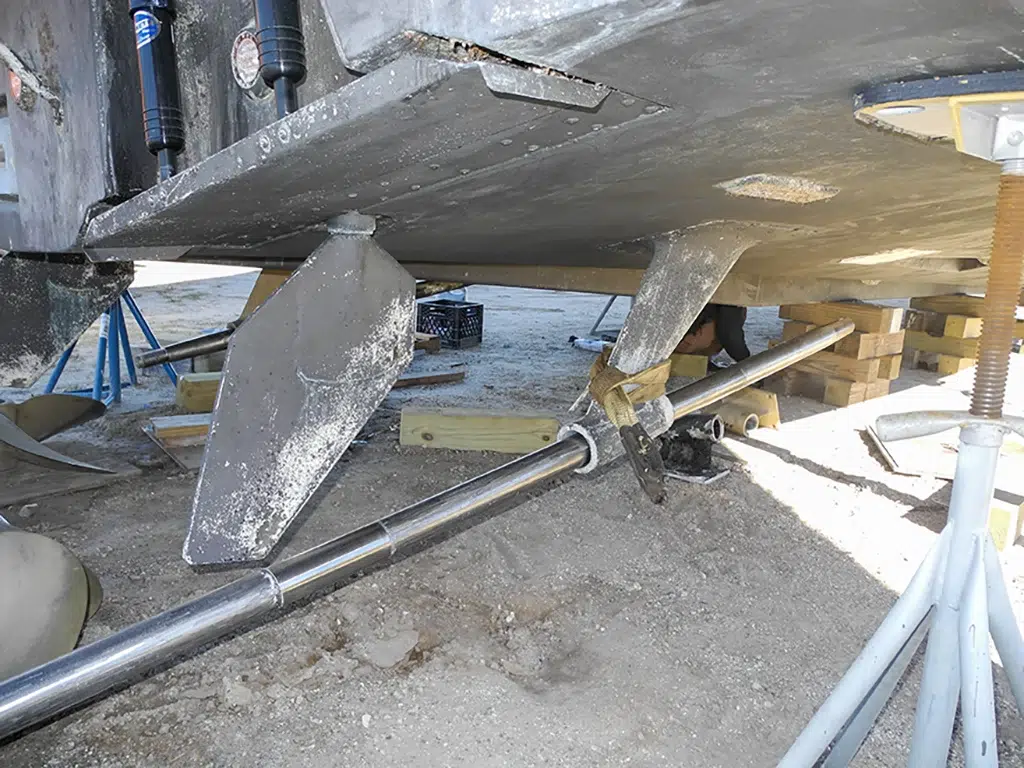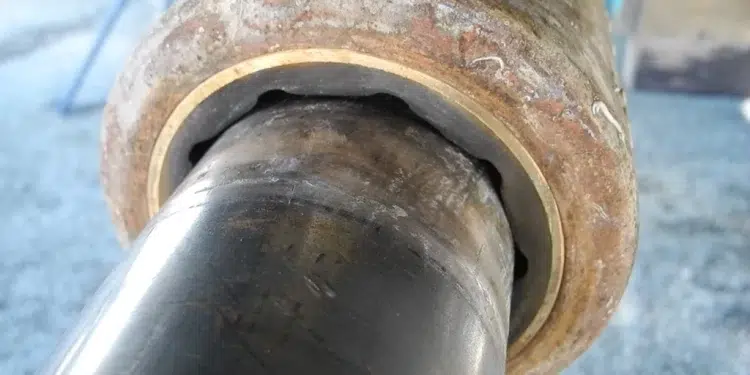Check Your Cutlass Bearing
Maintenance is essential to keep the propeller running smoothly.
When you hear the word cutlass, it may bring visions of a swashbuckler clanging swords on the high seas. A less glamorous but essential part of your boat’s running gear, the cutlass bearing is tucked away around the propeller shaft, rarely seen, and not often maintained. Neglecting boat maintenance can lead to unwanted problems. That’s why prioritizing your cutlass bearing maintenance is crucial.

Why You Should Care About Your Boat’s Cutlass Bearing
The cutlass bearing is an internal rubber sleeve pressed into the strut supporting the propeller shaft. Depending on your boat design, you may have one, two, or three struts per shaft. This is determined by the size of the propeller and the length of the shaft. These additional struts help keep the shaft straight and true, and every strut must be protected with a cutlass bearing.
That’s a lot of words, but do you care about the cutlass bearing yet? This nautical cutlass is usually made of a bronze or synthetic outer shell surrounding an inner rubber-like sleeve with grooves inside. The linear grooves are a part of the lubricating and cooling design. These grooves allow water flow around the spinning shaft. This prevents the fast-rotating propeller shaft from overheating and scoring the stainless steel shaft itself.
When you attend a marine survey before purchasing your boat, pay attention to what the surveyor looks for. Once the boat is hauled, the surveyor will squat, seeming to bench-press the propeller and shaft. They will attempt to lift the prop, sometimes even grabbing the rudder to wiggle it. If the boat is larger with a heavier propeller and shaft, the surveyor may use a different technique to learn the same information. You may see them grab a wooden block and a long board to serve as a lever. Either method will determine if the cutlass bearing has significant wear.
How it Should Work
The engine and reduction gear sitting on four or six engine mounts comprises the vessel drive train. This drive train is connected to the propeller shaft with a shaft coupling like a pipe flange. The shaft runs out from the engine room to the bottom of the boat through a shaft seal. This shaft seal may be the traditional style designed to have a slight drip to irrigate the seal or it may be a modern dripless design which relies on a stream of engine cooling water to irrigate and cool.
The propeller shaft then travels out through the bottom of the boat to the propeller. But before the shaft meets the propeller, it is supported by one or more struts. These are the rigid supports to keep the shaft aligned with the engine and transmission. They need to have a cutlass bearing to protect the shaft from metal-to-metal abrasion. A vented rubber insert provides this protection.
The simplest way to determine the condition of the cutlass bearing is to use the surveyor’s bench press method described earlier. Or, to be more precise, use a measuring device to check both the top and bottom gap in the annular fitting. Most boaters have their bottom painted every season or two at most, and this is a convenient time to inspect the cutlass bearing for wear. It would be difficult for a diver to check this because he would not have any lift ability when swimming.
DIY or Call in the Professionals?
You’re seeing signs of wear and tear and feel a replacement is on the horizon. This is where cutlass bearing maintenance knowledge will serve you well. A lot of websites show how you can make a threaded puller similar to a pulley puller. Contrary to popular belief, you may not be able to learn everything from the Internet. I believe by the time you buy the parts, tools, and equipment attempting to do it yourself, it is best to just hire the boatyard to do the job properly and safely.
First, they must remove the propeller and then set the hydraulic porta power unit in place on the shaft. This allows them to be properly positioned to hydraulically press out the cutlass bearing. Next, there are set screws holding the cutlass bearing in the strut. These screws must be removed before pressing out the old bearing. Now the new bearing must be pressed back into the strut. This is a very tight fit so the hydraulic porta power will be appreciated. I have seen some boatyards set the new bearing in a freezer for a while to help shrink the outer diameter to press back into the strut easier. I do not know if that helps, but I have seen it done.
Another key concern when installing the new cutlass bearing is understanding the space or distance between the end of the cutlass bearing and the propeller hub or a line cutter device. There must be enough space for water to flow through the bearing to cool the shaft. If there is not enough space, the bearing may overheat and wear out sooner than anticipated. This spacing may be best left to the professionals as well.
Tips for Ensuring Your Cutlass Bearing Lasts Longer
What can you expect of the life span of your new cutlass bearing? Assume 10 years or longer depending on usage variables, such as a misaligned propeller shaft, high-speed rotations, or use in sandy, abrasive water. And, of course, if you run aground and bend the strut, shaft, or propeller, then all bets are off. These can add to a vibration and prematurely wear the rubber insert of the cutlass bearing.
The best practice with cutlass bearing maintenance is to ask the professionals to inspect it every time you haul out. Save your DIY skills for another day—or watch and learn for the next time you want to check your cutlass bearing.
-by Chris Caldwell















thanks Chris.. the best advice I’ve seen on the internet.. already left some skin on the prop removing the securing bolt… boat yard taking over next week.